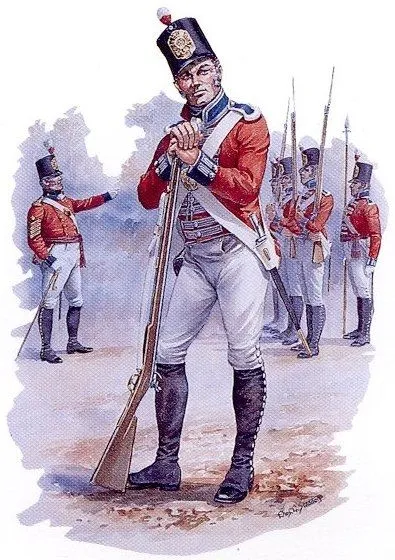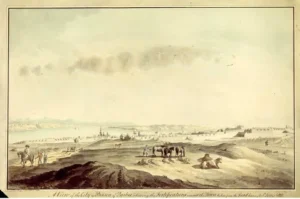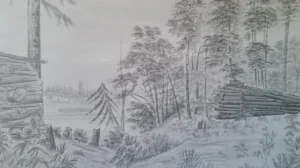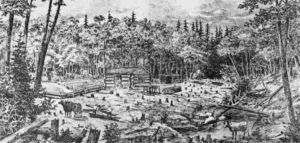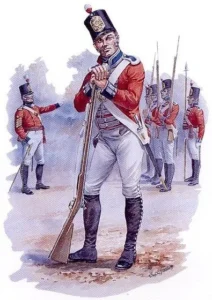
This is a uniform similar to one John may have worn
- Born: 1769, baptized 6 Oct 1769, Nuneaton, Warwickshire, England
- Married: 19 Apr 1795, to Susanna Payne (1765-1806) at the Church of St Mary, Bartlow, Cambridge, England
- Married: Dorothy (1781-1814), 6 Jan 1813, Quebec (city,) Lower Canada
- Married: Susanna or Susan Andrews (1775-bef 1842), widow of William Shields and Samuel Bird, St Andrews Presbyterian Church, Quebec (city), Quebec, Lower Canada
- Died: After 1843, Fallbrook, Bathurst Twp, Lanark County, Upper Canada
- Buried: Unknown, probably on property in Bathurst Twp (unmarked)
- Family Tree: Sergeant John Ashby
- Relationship to author: maternal great-great-great Grandfather
- Children: John and Susanna Payne, William (1788- ), Susannah (1793- ), Letitia (1796-1850), Patience (1800-1880), Harriett (1803-1882)
- Children: John and Dorothy (1781-abt 1814), widow of William Preston, Ann (1814- )
- Children: with John and Susanna Andrews (1775-bef 1842), Joseph (1817-abt 1817), William (1819-1899)
John Ashby (1769-abt1843) was the eldest son and one of a family of ten children. His parents Robert Ashby (1743-1783) and Elizabeth Yardley (1744-1783) were yet another generation in a long line of Ashby families.
John Ashby’s Military Career
Both John Ashby, my 3x great grandfather, and his brother Robert Ashby (1781- ) pursued successful military careers, John in the army, and Robert in the navy. John served in several regiments, enlisting in the 34th and 35th Foot Regiment on the 25th of March 1805. During the period of John’s service, the 34th (Cumberland) Regiment of Foot served under Regimental Colonel George Fitzroy, 2nd Lord Southampton. The Regiment served in the Cape of Good Hope in 1800 and in India in 1802. This group remained in a campaign against the Maratha Empire for nineteen years. A second battalion of the regiment formed in 1804.
John then transferred to the 38th Foot, 2nd Battalion on 30th October 1807. When the opportunity arose, John volunteered to join the 10th Royal Veteran Battalion and served in England and Jersey until July 1809. John volunteered for the 10th Royal Veteran Battalion. On 17 Dec 1810 he was appointed Corporal. Promises of land in Canada upon retirement, or the battalion’s disbandment, enticed men to pursue this option. Shortly after, the Battalion traveled to the Quebec garrison in Lower Canada.
Service in the Royal Veteran Battalion
Between 1802 and 1820, the British military raised 13 Royal Garrison Battalions which were renamed Royal Veteran Battalions in 1804. Members of these Battalions were army pensioners and invalids. They were destined to work in depots and stores doing administration and support work. The first group of the 10th Royal Veterans Battalion arrived in Canada in 1807 with a full complement of officers and 600 in other ranks. However, the arrival of able-bodied soldiers intended service during conflict was delayed.
When war broke out in 1812, the 10th was among the first into action. Some members saw active duty at Fort St. Joseph, and captured Fort Michilimackinac. The following year, members served at Raisin River and Fort Stephenson (Miami, FL). It is not known if John saw active duty. As new regiments of able bodied soldiers arrived in Canada, members of the 10th Royal Veterans were slowly withdrawn to the garrisons. For the remainder of their service in Canada they provided administrative and support services in Lower Canada, Prince Edward Island and Cape Breton.
In 1815, the battalion was renumbered as the 4th Royal Veteran Battalion and was disbanded in 1816. Fortunately, John chose to stay in Canada. On 10 November 1816, the ship transporting the families who chose to return to England was wrecked and 143 people drowned.
Progress through the Ranks
- On 17 December 1810 John was appointed Corporal.
- By 6th of January 1813, John’s had attained the rank of Lance Sergeant.
- By the 27th of October 1813, John was a Sergeant.
- In 1817, John is listed in the British Army Service Records with the Royal Regiment of Veterans, 4th Royal Veteran Battalion, pension payable in the colonies.
- After settlement in 1819, John participated in the local militia group under Col. Playfair. In later life, he served with the 3rd Battalion Incorporated Militia between 1838-1843.
Garrison Life
Daily rations for the men offered little variety and often had to be supplemented by the soldier. Every morning at nine o’clock the men were served bread, milk, soup, tea and occasionally butter. Dinner was served at noon and consisted of soup well thickened with meal, flour or rice, meat and vegetables. No supper was allotted for single men, but broth might be saved from the noon meal.
Women could live in the barracks if they provided cleaning, laundry, and cooking services for soldiers. They would receive full rations and be paid a wage. Others wives would be housed in a common barrack room or live outside the garrison. They would receive half rations. Children would be housed outside the garrison in the community. Children would receive one-quarter rations.
Soldiers eating with their families, apart from their comrades, typically would have milk and bread for breakfast, meat, vegetables, salt and bread for dinner, and milk and potatoes or broth with bread for supper. Beef, both fresh and salted, was available to the garrisons from local farmers, while mutton was usually reserved for celebrations.
Some men supplemented rations with privately purchased cheese or pork. Salt pork was also available. Cabbage, peas and beans were favored vegetables. Fish was used with caution as it spoiled quickly and could lead to outbreaks of dysentery. Hunting allowed a soldier to add grouse, pigeons etc. to his diet. Wild fruit was added to the diet when available. Locally grown and milled wheat was used for flour. The local bread was deemed better than that available at home!
The struggle to survive garrison life was good training for survival as a settler!
Marriages and Children
First Marriage
John Ashby married Susanna Payne in 1795 in Cambridge, England. When he enlisted in the military in 1805, John left a young family in his wife’s care. Susanna Payne died in 1806 in Surrey England at the age of forty-one. John and Susanna had five children, three of whom are known to have survived to adulthood. Little more is known of this family.
At the time, the military was severely limiting the number of families who could accompany soldiers when they were posted, especially when posted outside Britain. In many cases, only commission officers could be accompanied. The quota was six to twelve women per one hundred men. As a result, men sometime partnered as they moved from station to station, leaving abandon families in their wake. These abandoned families sometimes became a burden for parishes and various attempts were made to address this issue. On the other hand, life for women and children in a military garrison was often grim.
Second Marriage
On the 6th of January 1813 John Ashby, Lance Sergeant of the 10th Veteran Battalion, a widower, was married by license of Sir George Prevost, to Dorothy ?, (Preston) of Quebec, a widow. A daughter, Ann Ashby, was born about 1814 and it seems that both Dorothy and the baby died at this time.
Third Marriage
On 26th February 1816, in St. Andrew’s Church, Quebec, Sergeant John Ashby, of the 4th Royal Veterans Battalion, aged about 45 years, widower, married a widow, Susanna Andrews, widow, (previously married Shields (7 Apr 1800) and Bird (7 Mar 1808), of Quebec, by license of Sir Gordon Drummond at Quebec.
John and Susanna’s Story
Susanna Andrews outlived two previous military husbands and throughout her lifetime bore eight children. Joseph, the first son of John and Susanna Ashby, and Susanna’s seventh child, was born August 1817 and was baptized in Perth Ontario, but did not survive. William Ashby, Susanna’s eighth child, and my 2nd great grandfather, was born July 1819 near Fallbrook, Lanark County, Upper Canada. He was the only child of Susanna’s to survive to adulthood.
Five of Susanna’s previous children died as infants. A sixth, a daughter, was accidentally shot and died of a pistol wound at age seven. Unsanitary living conditions and scarce food supplies made life in the garrison difficult. Medical care was limited and weapons were everywhere. It was not a favorable environment for children.
The Search for a Home
Front of Young township, Leeds county, Johnstown district
In 1817, Sgt. John Ashby (Ashley) received an initial location ticket for all of lot 24 in concession 2, Front of Yonge Township, Leeds County, Upper Canada. This property is slightly to the north west of the village of Mallorytown. An investigation of this property reveals that it was swamp-land draining into Jones creek. Jones creek flows through the southern end of the property. Early maps indicate much more open water on the creek than is visible on today’s GIS maps. This suggests that the water table has changed. Today this area remains undeveloped. Farmland in the township begins in concession 3.
Kitley township, Leeds county, Johnstown district
A second location ticket was obtained in Leeds County near Frankville but was abandoned in favor of a ticket issued for lot 19 SW concession 10 in Kitley township, Leeds county, District of Johnstown.
Bathurst township, Lanark county, Bathurst district
In 1819, the survey of Bathurst township was finally completed. John sought a lot here. The Bathurst lot, concession 10 Lot 19 W, was a remote property located on Bolton Creek. the lot was originally located where water flows out of Bennett Lake. Today the water level in the lake has dropped and the shoreline of the lake is not close to the property. The lot is about two miles from the village of Fallbrook. The Ashby family settled on their lot about 1817 and John received his crown patent on the 8th of September 1820, having completed his settlement requirements.
Getting Settled
As in other communities, a senior officer in the community organized military settlers into work crews to share the work. They built a shanty and cleared enough land on each lot to meet patent requirements. Col Playfair was most likely the organizer in this community. When one considers the nature of the land that these families settle on, one wonders why they chose to do so. Colonel Playfair is quoted as saying that he, “came far back from the frontier to avoid the horrors experienced during the war of 1812.” Other shared the sentiments of Col. Playfair and followed him into the backwoods.
The Early Years
Finding a home in Upper Canada was a challenge for John and Susan but imagine their delight when they arrived at their allotment in Bathurst Township. Tall trees covered the hillside although some oak harvesting may have already occurred. Blue lake waters sparkled in the sunlight. Wildlife abounded in the forests and fish in the lake. Birds flew overhead and wild geese migrated through in the spring and fall. Berry bushes could be found in forest openings.
During that spring or summer of 1817, John aged 48, and Susanna aged 42, prepared for winter in a log shanty on the hill overlooking the lake. John, accustomed to hunting for birds and game, and Susanne who had survived life as a garrison wife, had knowledge of food preservation and of edible and medicinal plants. Other supplies were carried from Perth, or even Brockville, during the first few years. First Nations people who lived in the area often befriended the settlers and taught additional survival skills.
Impact of the Timber Trade
When John and Susanna arrived at their new home, the timber trade was firmly established along the Ottawa river and soon turned its attention to the trees in the Mississippi watershed. The Madawaska and Mississippi and their tributaries, river highways made famous by the exploits and conflicts of the Caldwell and McLaren timber concerns, made the area attractive. In turn, the timber trade made this area desirable for settlement in the early 1800s.
On the 17th of September 1831 John sold a piece of his property for a mill site to Benjamin and Samuel Bolton, a United Empire Loyalist family. Logs were floated down the lake and it was an ideal location for a sawmill to service the needs of the settlers. A road between Fallbrook and Watson’s Corners ran along a portion of the Ashby lot. A simple bridge was built to cross the creek. This quickly became a major route servicing timber shanties located to the north of the lake.
Many settlers decided to move on when logging slowed and the land under the trees was revealed. There was little potential for agricultural activities on the land they had settled. in 1835, Mr. C. Rankin, was commissioned to report on the situation of 1820-21 assisted settlers in the vicinity. He described the land as “a continuous succession of rocky knolls with scraps or bits, seldom exceeding an acre in extent, of good land between.” Along the creek, the rocky knolls drained into low-lying swamp.
The Neighbourhood
Some of the lots nearby were second or third grants to officers. The officers made their homes elsewhere. As a result, many of these lots remained patented but vacant land for many years. Often squatters lived on these properties for a time and then moved on. John and Suzanne’s home remained somewhat isolated as only a few land owners chose to live or to remain on their lot. The village of Fallbrook developed quickly. The community grew quickly as several hotels, saw mills, a grist mill and a shingle factory expanded the business sector of the community. As it grew, the village became a stopping place for teamster travelling to and from the logging camps. Once famous as the home of Walter Cameron, famous blacksmith of Lanark County, Fallbrook is a pretty rural hamlet.
Today the Ashby property is a “country property” in “cottage country.” Few descendants of the original settler families remain. The Ennis family operates a popular cottage resort. On the north side of the 10th line of Bathurst, the Foster’s from Ireland who received their patent in 1826, live nearby. Richard Jones, Wentworth Winslow and William Matheson received patents in 1820. Their lots were probably military grants. Some of these lots remained unoccupied for many years. On the south side of the 10th line only Robert Moore, Charles Duncan, James Warner receive patents in 1820-21. Theophilus Bartlett, James Ward and Henry Watts received their patents in 1824. Many of the later arrivals sought proximity to the timber trade and hoped to purchase land from the patent holders. While the Watt and Foster families intermarried with Ashby descendants, other names of settlers soon disappeared from records.
Although their early days of their life on the 10th line of Bathurst township were difficult, I like to think that, John and Susanna Ashby lived a good life. However, life in the vicinity of Fallbrook, was to become more complex for later generations.

